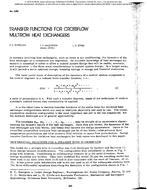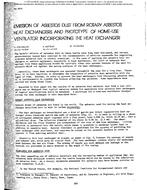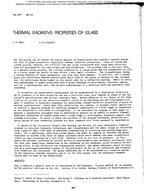-
-
Available Formats
- Options
- Availability
- Priced From ( in USD )
-
Available Formats
-
- Immediate download
-
$16.00Members pay $7.00
- Add to Cart
Customers Who Bought This Also Bought
-

BO-2380 -- Transfer Functions for Crossflow Multirow Heat...
Priced From $16.00 -

BO-2365 -- Energy Uage and Relative Utilization Efficienc...
Priced From $16.00 -

BO-2375 -- Emission of Asbestos Dust from rotary Asbestos...
Priced From $16.00 -

BO-2377(RP 114) -- Thermal Radiative Properties of Glass
Priced From $16.00
About This Item
Full Description
The finned-tube hot-water boiler (Fig. 1 and 2) is a relatively new concept hot-water generator as compared to cast iron (fig. 3), Scotch marine (Fig. 4) and bare-tube (Fig. 5 and 6) boilers. It is finding wide acceptance because of its light weight, compact size, high re- . covery, and low standby loss. These features are made possible by the use of finned tubes that permit the design of an extremely compact heat exchanger of minimum water content (Fig. 7).
One would normally expect a finned-tube boiler to require the same total area of heat transfer surface as required by other boilers, the major portion of the heat transfer area would merely consist of fins rather than bare tubes or cast surfaces. However, the use of finned tubes permits a reduction of the required heat transfer surface as compared to conventional boilers of equal capacity.
It has been traditional in the boiler industry to require a minimum of 5 sq ft of heat transfer surface per boiler horsepower. Fig. 8 is an excerpt from MIL-B-18897D, Amendment 1 and specifies that water-tube boilers have a heat exchanger loading of 6, 200 Btu/hr/sq ft; this corresponds to 5. 4 sq ft/boiler horsepower. Yet, boilers made of finned tubes require less heat transfer surface. Fig. 9 is an excerpt of a data sheet from an American Gas Association report on a line of finned tube boilers that were tested and certified by the American Gas Association Laboratories. Fig. 9 shows that the Model 1630 has a heat exchanger loading of 10,069 Btu/hr/sq ft; this corresponds to 3. 02 sq ft/boiler horsepower. The purpose of this paper is to explain why finned-tube boilers require less heat transfer area and to demonstrate the significant effect that the equivalent diameter of the flow path has on convection heat transfer.
This reduced heat transfer area requirement for finned-tube boilers is no disadvantage, as it permits the construction of a compact heat exchanger with minimum water content and small metal mass. As less energy is stored in the water and metal mass,, the standby losses of finned- tube boilers are minimized.





